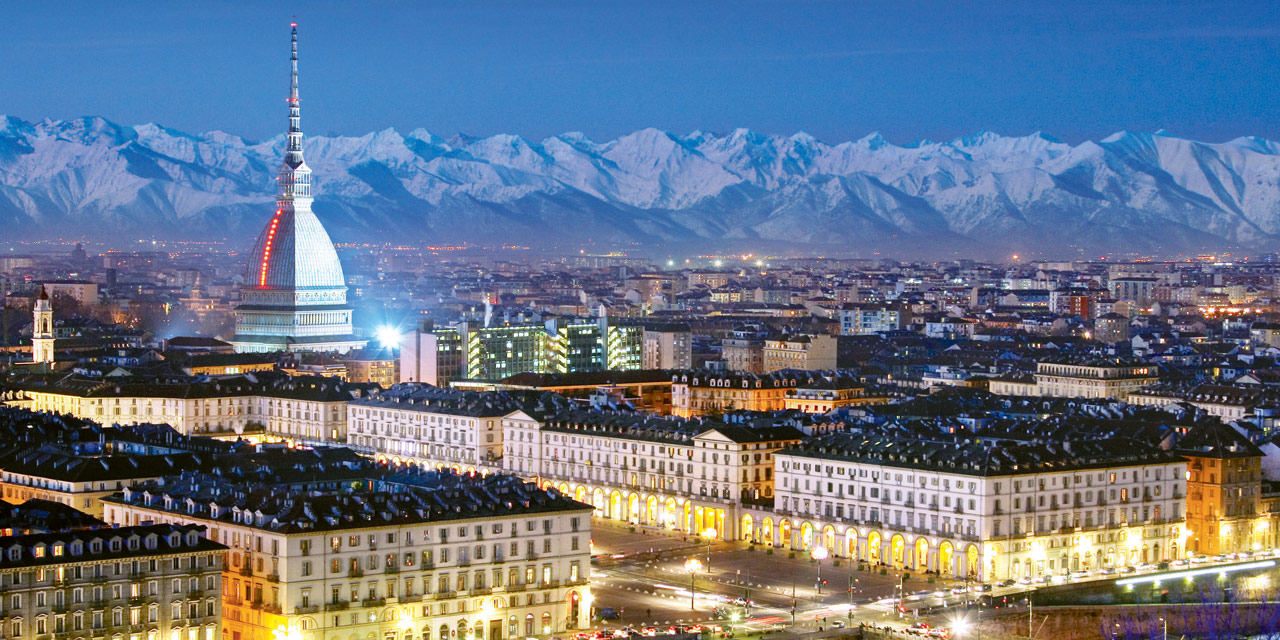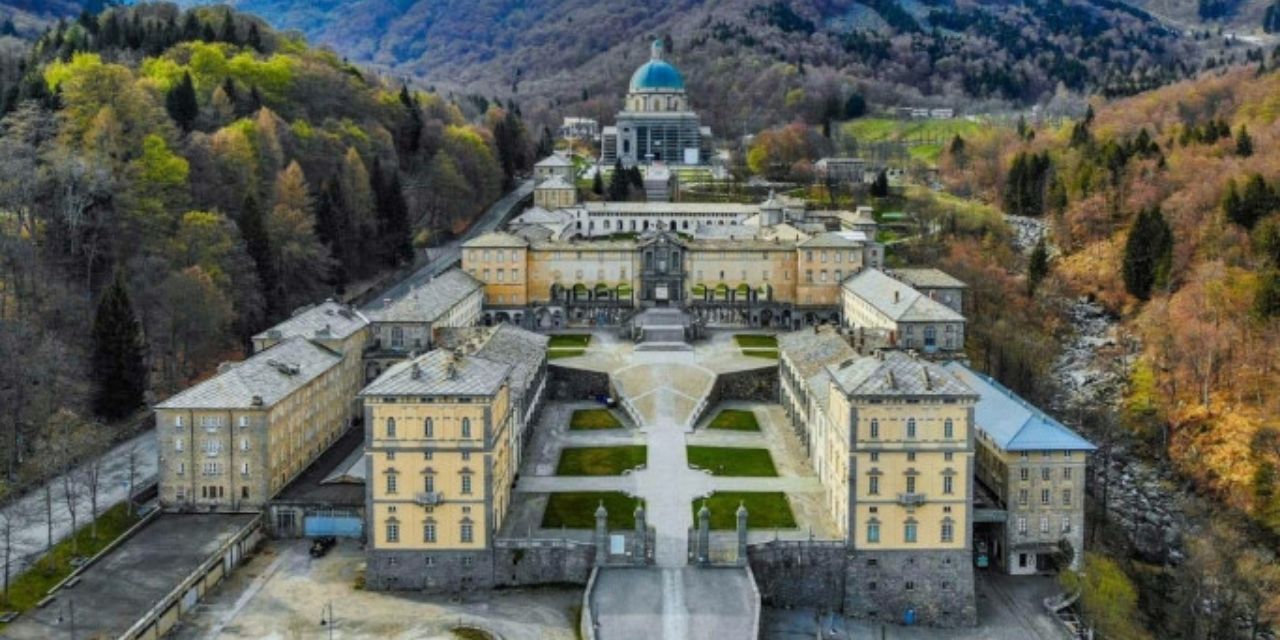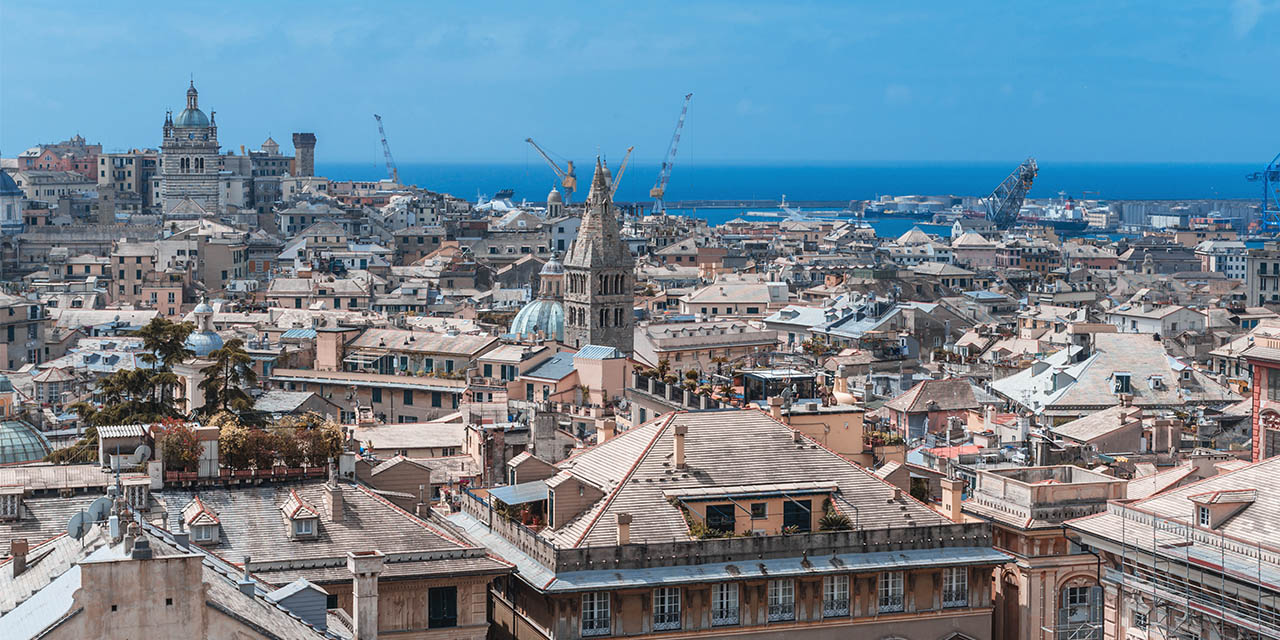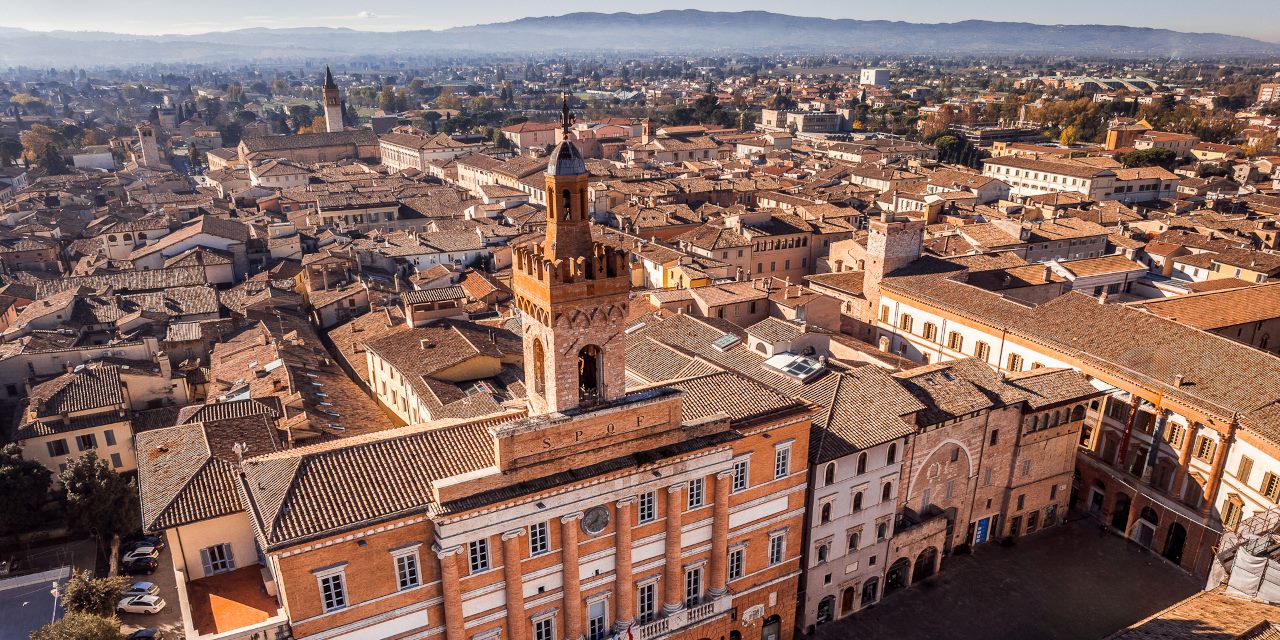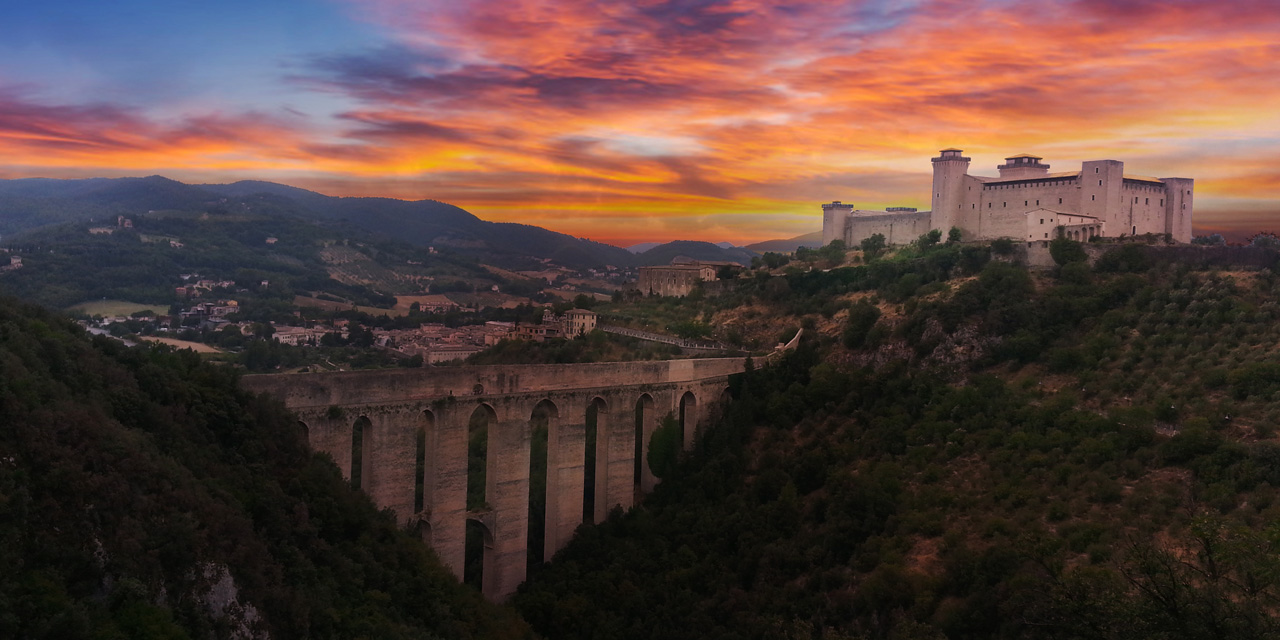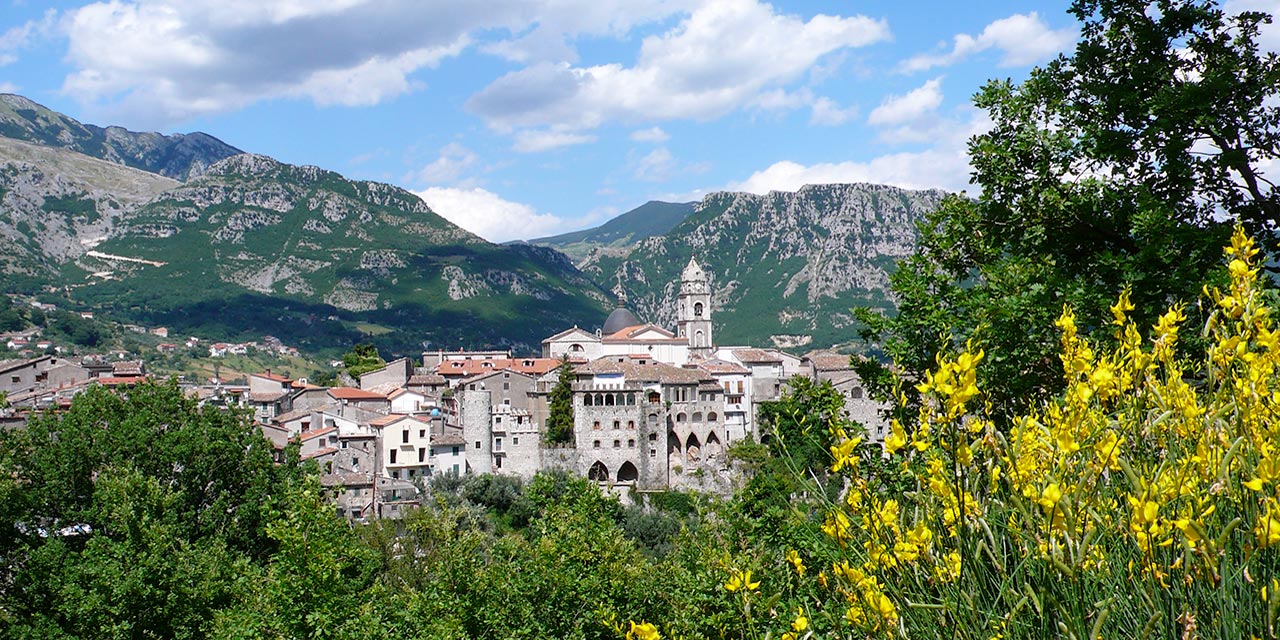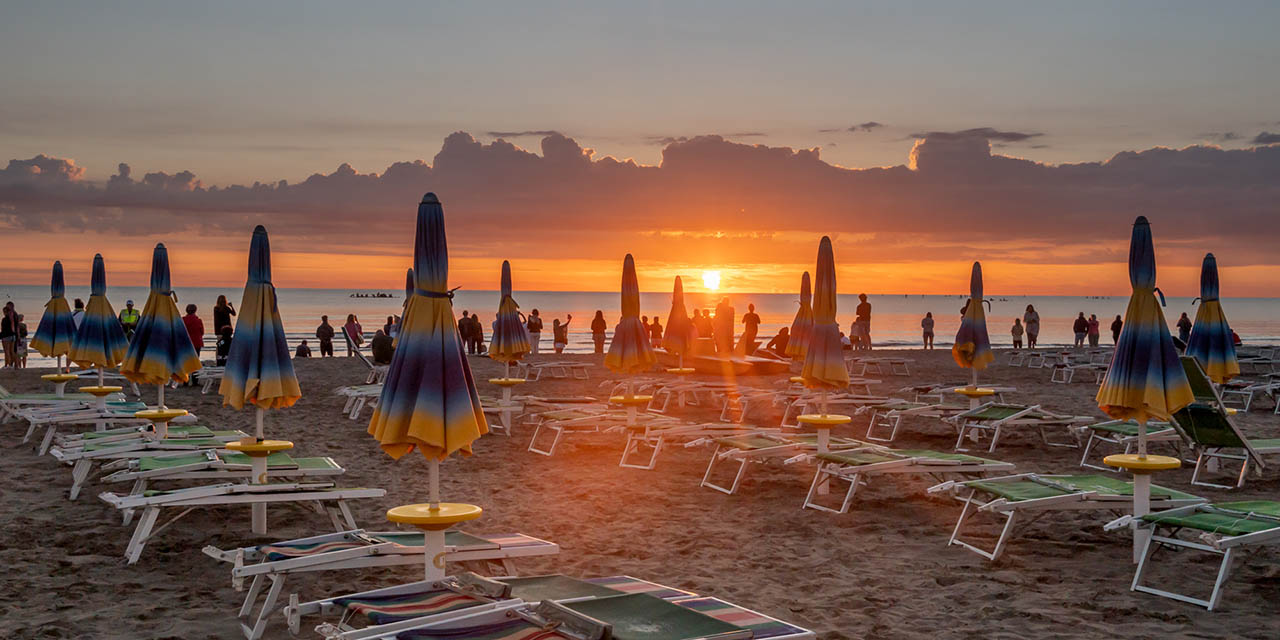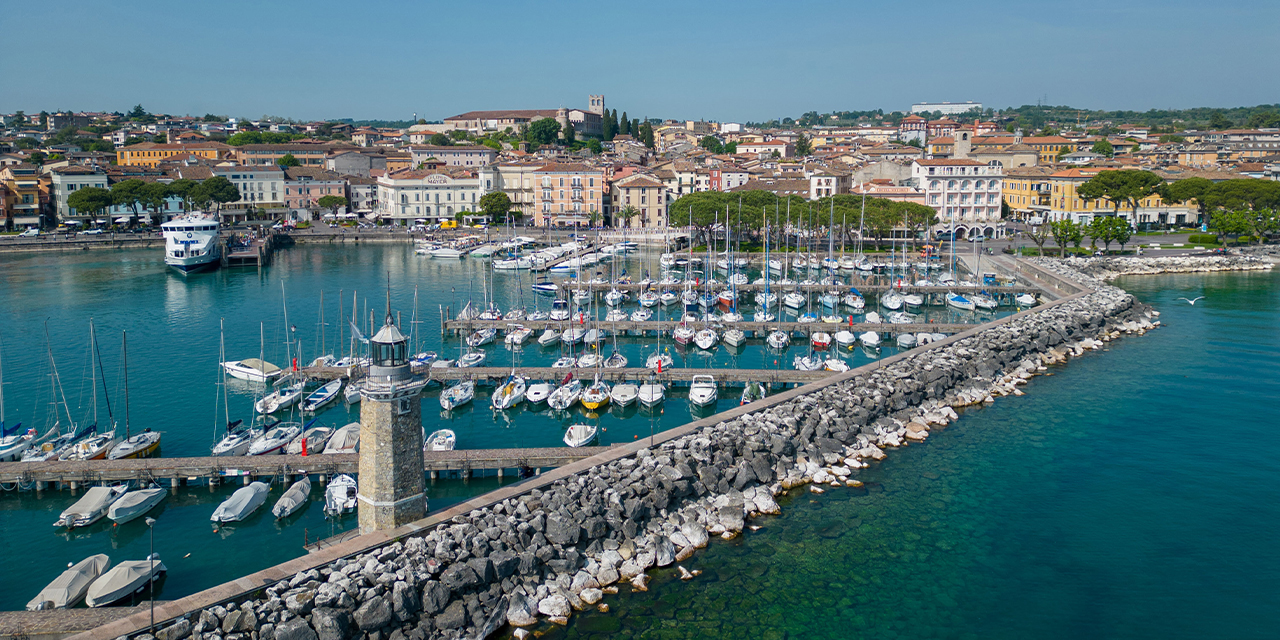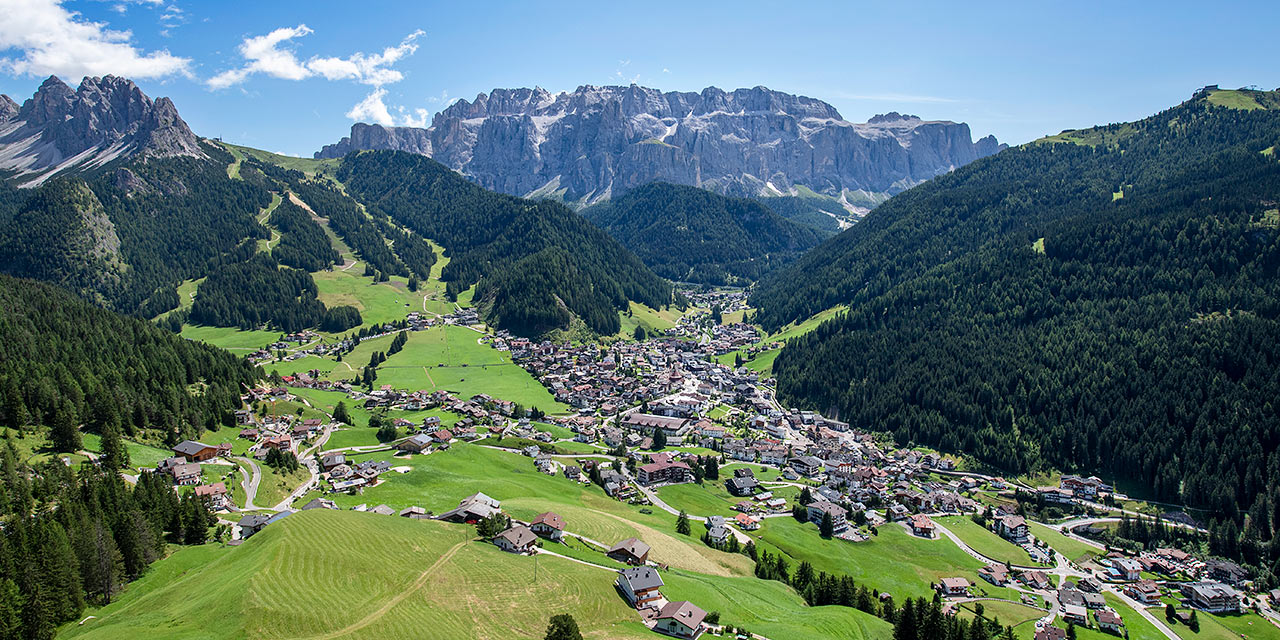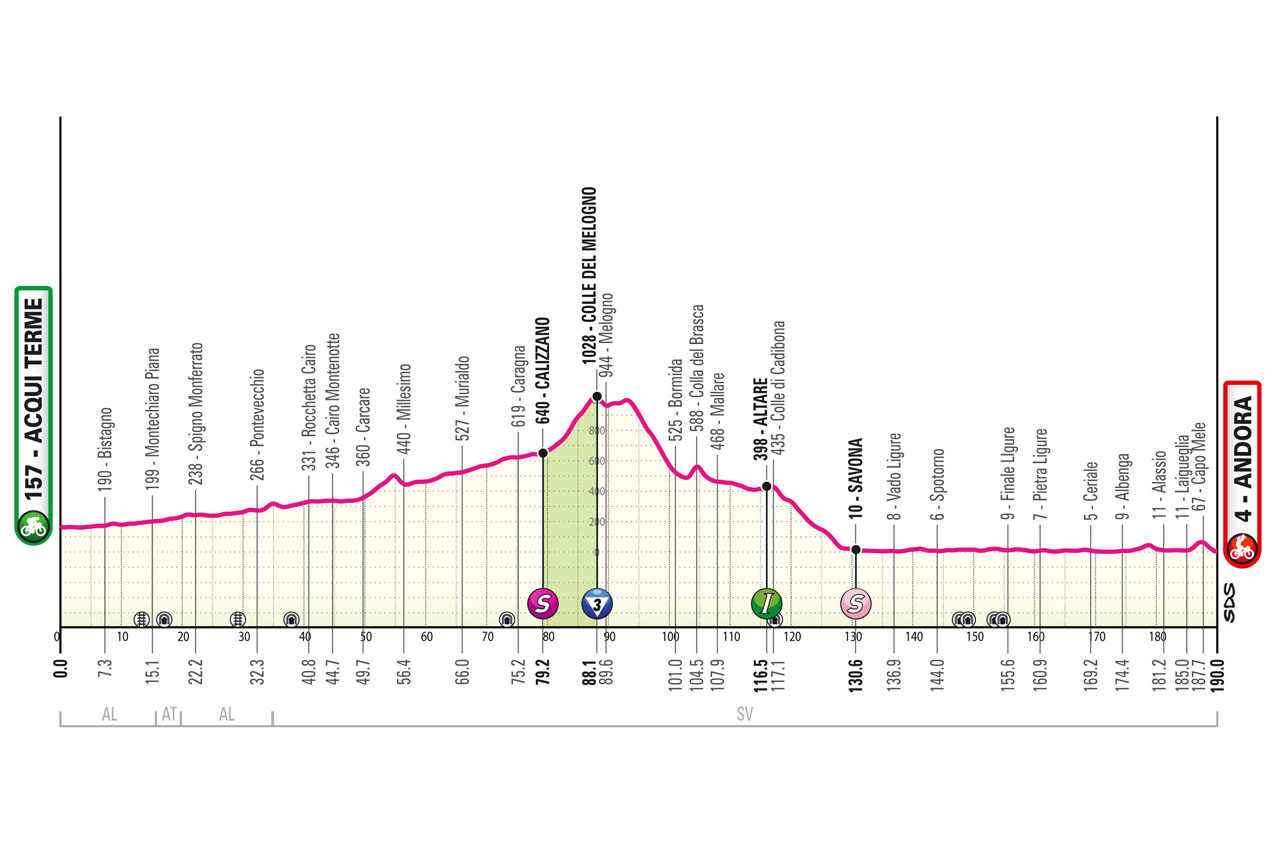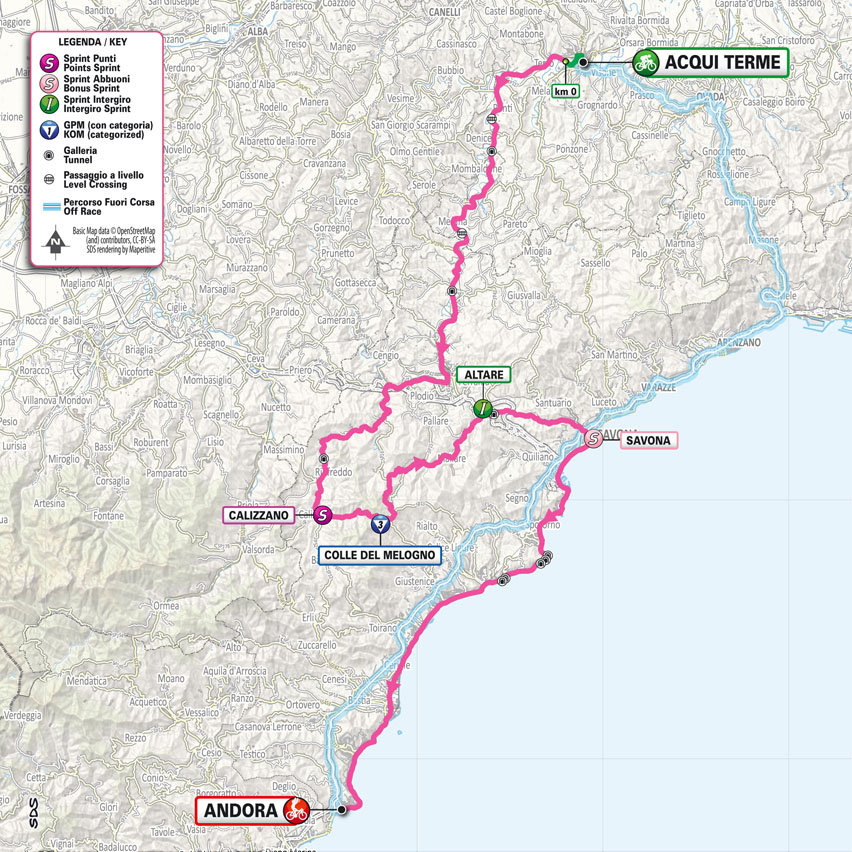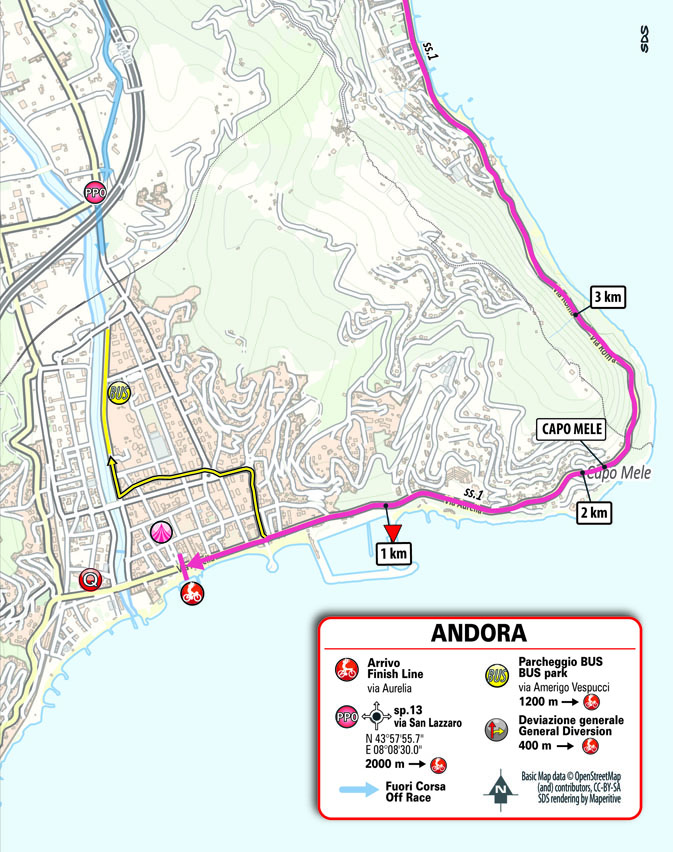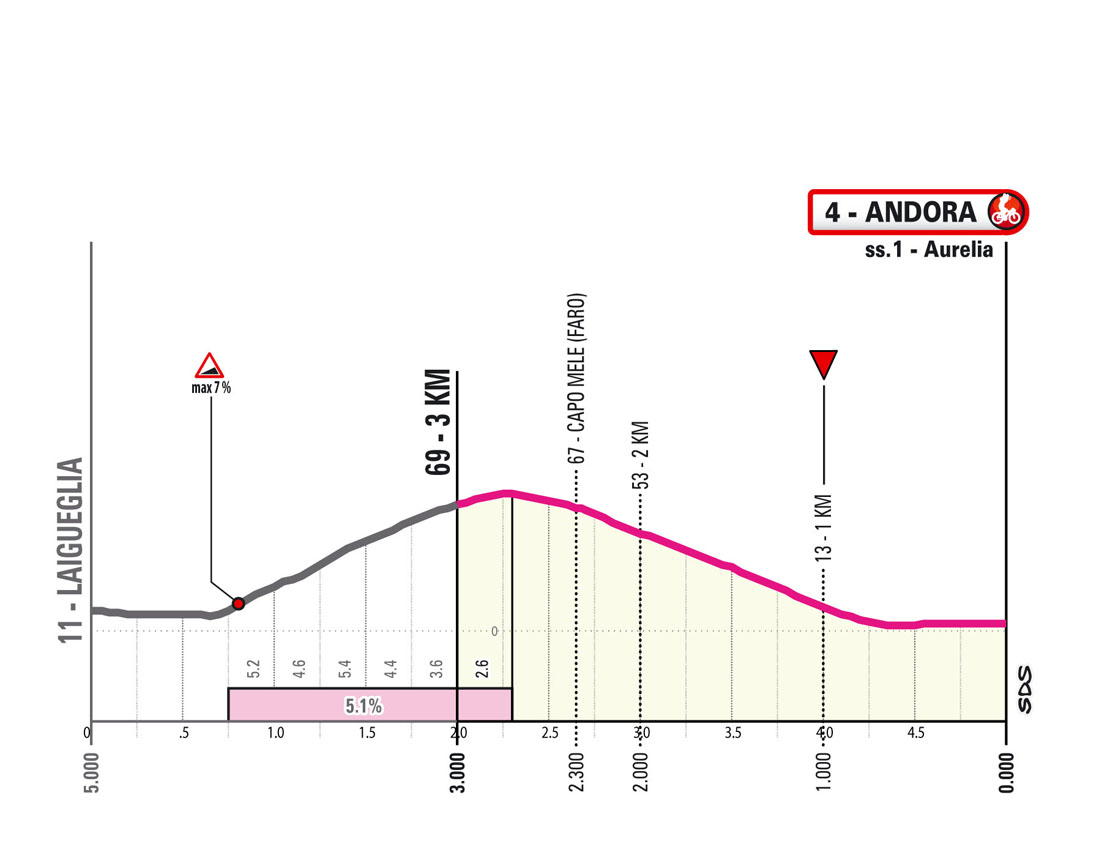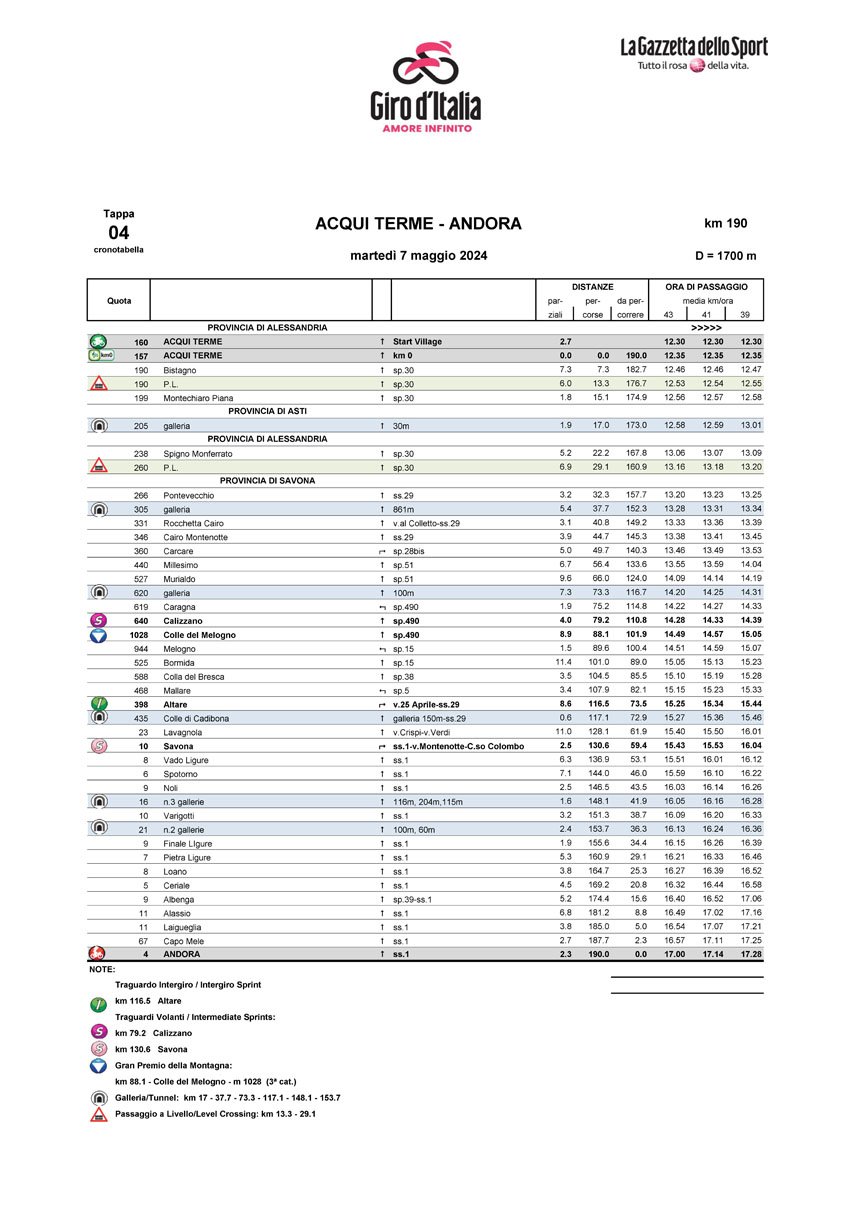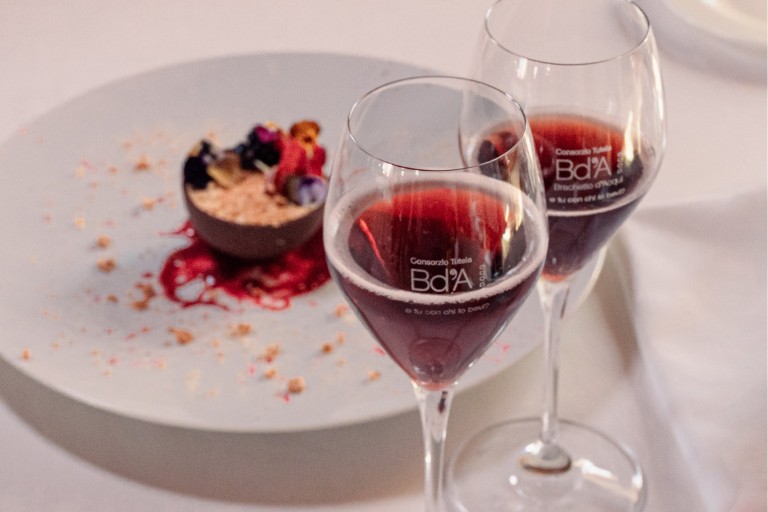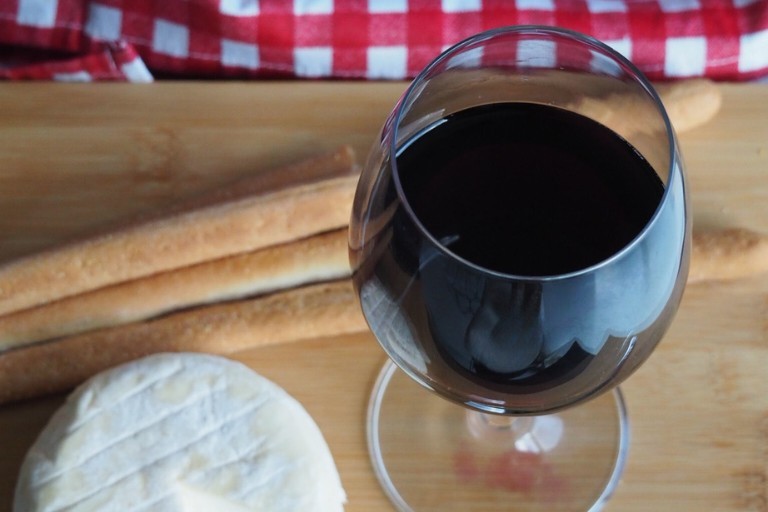profile
map
technical info
A fairly flat stage, the only obstacles are the Col di Melogno climb (8 km at around 5%) midway through the stage and the final Capo Mele, which is tackled from the same side as during the Milano-Sanremo. The finishing venue lies at the foot of Capo Mele and is approached along the well-known route of La Classicissima.
Last kilometres
The last 3 km are mostly downhill. Once past Capo Mele, the road descends in a series of semi-curves to the town of Andora. The last 800 m are straight and perfectly flat on an 8 m wide asphalt road.
start / finish
final kilometres
itinerary timetable
tourist info
Host city:
Acqui Terme
Overview
Acqui Terme is a fascinating spa town already renowned in Roman times for its steaming waters. It is surrounded by vineyards and landscapes recognised in 2014 as a UNESCO World Heritage Site for their breathtaking beauty. Located in the province of Alessandria, a borderland between Piedmont and Liguria in the Alto Monferrato area, this town is rich in environmental, landscape, artistic and eno-gastronomic attractions, not far from the large cities of Genoa, Milan and Turin. The imposing remains of the Roman aqueduct bear witness to the importance that water has always had for this town, which offers its visitors an enviable combination of art, culture, history, gastronomic excellence, charm and Italian hospitality that make it a unique and captivating destination.
Local Cusine
Acqui Terme offers an excellent choice of typical restaurants, elegant ones, trattorias, inns and agriturismi (farmhouses usually serving guests food that was prepared from raw materials produced on the farm or from other local merchants).
This is a land to savour through its food and wine treasures. The gastronomy, though characterised by simplicity, is very rich, consisting of dishes based on local seasonal ingredients. Most dishes have poor origins derived from the modest economic conditions of the area during past centuries, and despite having been enriched over time, they have never lost their primary ingredient: authenticity.
Typical of the local cuisine are a rich selection of starters, including the “filetto baciato” salami, an absolute delight, cacciatorini, lard, peppers with bagna cauda and a variety of savoury pies. Among the first courses, tajarin with mushrooms or game sauces, agnolotti al plin, polenta, cisrò – farinata – deserve a special mention, and among the second courses, the local meats, mixed boiled meat, rabbit, braised meat, tripe, but also stockfish, finanziera, Piedmontese fritto misto and bagna cauda, the convivial dish par excellence, all represent unforgettable dining experiences. Hence the birth of a renowned speciality such as Stoccafisso all’acquese, an iconic recipe handed down from generation to generation and present on several menus in Acqui’s restaurants.
Other local specialities include amaretti biscuits, baci di dama (lady’s kisses), brut e bon, Acquesi al Rhum and Canelin’s award-winning turrón, recognised together with the local artisanal ice cream as one of Italy’s best products!
The highly appreciated truffle, one of the top products of the region, grows underground throughout the local area, in harmony with oak, willow, linden and poplar trees.
Porcini mushrooms, delicious and abundant in our valleys, are much sought after by gourmets in the autumn months.
Roccaverano DOP – (literally “Protected Designation of Origin”) – A product that symbolises the hard work behind mountain sheep/goat farming. This goat’s cheese – a blend of the fragrances, flowers and herbs of the area, produced fresh or matured – appears to this day to be the only one capable of equalling if not surpassing the legendary French cheeses.
Filetto baciato – a renowned product of Aquitaine gastronomy, the filetto baciato is a unique kind of cured meat, invented by the Malò (Ponzone) family at the beginning of the last century and obtained by stuffing salami paste around the pork fillet.
Wine and other drinks
The Alto Monferrato territory and the entire Acqui area is a wonderful land surrounded by picturesque vineyards producing excellent wines appreciated all over the world. Visitors and encouraged to explore our wineries and the Regional Wine Cellar, where you can taste the best wines, visit the characteristic and historic cellars, discover how wine is made, learn about the perfect gastronomic combination of wine and food, and stroll through the vineyards! The vineyards are an unmistakable presence in the Acquese territory. For generations, the skilful cultivation of grapes has produced excellent wines, among which Acqui DOCG, Brachetto d’Acqui DOCG and Dolcetto d’Acqui DOC stand out as typical wines. Additionally, wines are produced from the cultivation of prized grapes such as Barbera, Freisa, Dolcetto, Cortese, Chardonnay, as well as the renowned aromatic essences of Brachetto and Moscato to be enjoyed in sweet, sparkling, rosé and passito versions.
Points of Interest
- The Bollente kiosk and thermal spring: the town’s undisputed symbolic monument and a mandatory stop for visitors. A true gift of nature, thermal water gushes out at an incredible rate of 560 litres per minute at a temperature of 74.5 C. The intervention of the municipal administration led by Giuseppe Saracco radically transformed the ancient area around the spring of the same name by demolishing the old Jewish Ghetto (1870-1880). Engineer Giovanni Ceruti was responsible for the eclectic-style shrine-temple (1879), which highlights the importance of the place. The civic tower dates back to 1763 and was built to a design by the Alessandria-based architect Giuseppe Domenico Trolli over the arch of the ancient Porta della Bollente.
- The Cathedral of Santa Maria Assunta: for over ten centuries it has been the landmark of all urban and diocesan life. This cathedral stands on the square overlooked by the 15th-century Bishop’s Palace and the Diocesan Seminary, close to the massive fortress of the Castle.
- Paleologi Castle, Municipal Archaeological Museum: the castle of Acqui Terme, known as “dei Paleologi”, dates back in its original layout to the 11th century. It was, at first, the residence of the bishop-counts of Acqui, who lived there until violent internal clashes between the town’s noble families put an end to their rule. It later became the stronghold of the mediaeval village of Acqui and the seat of the town’s governors before passing to the Marquises Paleologi del Monferrato in 1260. Starting in 1708, the complex came under the direct administration of the House of Savoy, who progressively deprived it of its original function as a fortress, assigning it, from the early 19th century, to the function of prison that it maintained until recent years. Today it is home to the Municipal Archaeological Museum, which houses interesting remains from prehistoric and protohistoric times, the Roman era and the late antique and medieval periods.
- Il Giardino Botanico “Birdgarden” is located within the castle walls and is a natural oasis in the heart of the city.
- Basilica of Our Lady of Sorrows, formerly St Peter’s Monastery
- Church of Saint Francis
- The “Jona Ottolenghi” Foundation
- The Bishop’s Palace
- Borgo Pisterna: this is the ancient heart of Acqui Terme, where the streets are lined with houses and noble palaces of great artistic value, dating from the 15th to the 18th century, that have recently been refurbished and revalued. This area is also the setting for shows held throughout the summer at the ‘G.Verdi Open-air Theatre.
- Piazza Italia: it is the town’s central square, criss-crossed with the scenic stepped fountains of the “Water Lilies” that descend from Corso Viganò towards the centre of the square.
- Palazzo Lupi – the Town Hall
- Villa Ottolenghi Wedekind
- The Rotten Water Temple: located in the bathing area, beyond the river. It is a thermal water spring with a much lower flow rate than the other springs, gushing out at 19°C.
The Roman aqueduct: the arches of the Roman aqueduct constitute one of the historical boasts of the city of Acqui. Indeed, this is the best preserved of all monuments of its kind still existing in the territory of present-day Piedmont and one of the most significant examples of Roman aqueducts in the whole of northern Italy. The construction of this system can be traced back to the early imperial age, perhaps to the Augustan period (early 1st century a.C.). - The Roman Pool: remains from a vast thermal complex dating back to the Imperial age, found in 1913. It is a vast hot-water pool (calidarium) originally entirely lined with marble slabs and flanked by several rooms heated through a hypocaust system. The water for the facility was brought through a canal directly from the source of the Bollente. The thermal building, together with the nearby amphitheatre discovered in the 1960s, occupied a peripheral area of the ancient Roman Aquae Statiellae, outside the built-up area but convenient to reach via the Via Aemilia Scauri.
Andora
Overview
Andora is a seaside resort with lovely beaches of very fine sand (a rarity in Liguria), a hinterland made of olive groves and footpaths, and a vibrant marina.
Local Cusine
If you love the pleasures of gastronomy, don’t miss the fish market in the harbour or a visit to the agricultural producers of the plain, who are the source of many excellent food and wine products that can be tasted in renowned restaurants.
Andora is the second most important plain for the production of Genovese D.O.P. basil, whose intense aroma fills the air at peak harvest time. Extra virgin olive oil is produced in the nearby hinterland, where local estates await visitors to introduce them to the so-called yellow gold and the cultivation and production techniques of the Val Merula. Also worth tasting is the Belendina onion, a recent Slow Food Presidium.
Points of Interest
- Andora Bike Theatre: this is a sports tourism project that offers enthusiasts 150 km of scenic trails, including 54 km of footpaths, divided into 4 loop trails of varying difficulty for hiking or biking.
- Colla Micheri: it was Thor Heyerdahl, the great Norwegian explorer, who fell in love with Colla Micheri in the 1950s. This is a village of sublime beauty that he restored and preserved together with the hill overlooking the gulf of Andora: it is among the most beautiful villages in western Liguria.
- Rollo: it is a small, charming village in the midst of olive groves, with a splendid view of the sea: a venue for events dedicated to herbs, flowers and good music, it is the arrival and departure point for pleasant walks in the green.
- Conna: this is a place where the privilege of experiencing countryside peace just a few kilometres from the coast can be fully appreciated. Andora is part of the national association Città dell’Olio (Oil Cities), and it is precisely from Conna and from Borgata Garassini that evocative walks among the olive trees begin, allowing visitors to discover centuries-old olive groves, some of which lead to the distinguished village of Duomo, an ancient settlement of stone houses, immersed in the green.
- Castello: this is the oldest centre of Andora, home to the fortified Paraxo complex and the beautiful Church of Saints James and Philip, a treasure of late Ligurian Romanesque style with perfect acoustics. The entire village is currently undergoing a pilot project of urban, cultural, social and economic regeneration supported by the National Recovery and Resilience Plan. In 2026, when the work is completed, Borgo Castello will offer unique experiences thanks to dynamic virtual reality in its most advanced form.
- Palazzo Tagliaferro: to Thor Heyerdahl, Andora has dedicated its central Pier and an exhibition space in Palazzo Tagliaferro, which is home to the Luciano Dabroi Mineralogical Museum and the Centre for Contemporary Culture that hosts nationally and internationally renowned artists.
- The Marina area: Blue Flag non-stop since 1987, UNI EN ISO 14001 certified and a Four Star Marina Resort, this area offers 862 berths. Managed by Azienda Multiservizi Andora S.r.l. (www.amandora.it.), it was the first marina in Liguria to boast the E.m.as registration, which guarantees the implementation of all the procedures to ensure environmental protection required by the European Commission. The delivery of the certificate took place during the last Genoa Boat Show at the Assonat stand. The port of Andora was also awarded for its environmental commitment twice at Ecomondo in Rimini.











